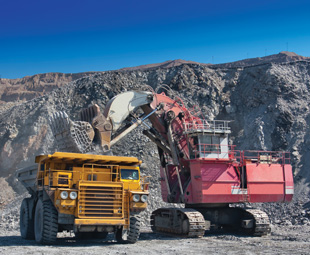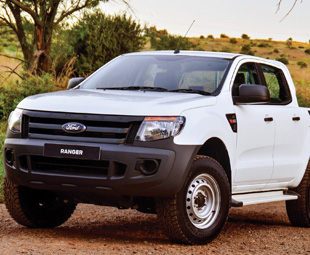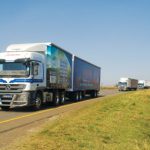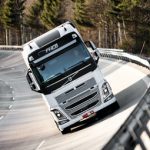Mining mayhem over manoeuvrability?

Africa is renowned, and coveted, for her natural resources – especially those she holds enveloped underneath her crust … The process of unearthing these riches, and getting them to market isn’t, however, for the faint-hearted. JACO DE KLERK delves into some of the challenges faced by the mining industry and its supporting sectors
Mining has had a huge influence on South Africa’s political, social and economic development. Wars have been waged over its resources, and whole towns have been created to support these activities … and it remains an important sector. Mining contributes, on average, 20 percent of South Africa’s gross domestic product (GDP) – as reported on Mining IQ (a online information portal powered by Projects IQ, an independent South African-based provider of information on African mining projects).
South Africa isn’t the only country on the continent that’s reliant on underground riches as an economic driver … In Namibia, mining accounts for eight percent of GDP, but provides more than 50 percent of foreign exchange earnings – according to The World Factbook. (This is a publication of the Central Intelligence Agency (better known as the CIA), an independent agency responsible for providing national security intelligence to senior Unites States policymakers – regardless of what Hollywood depicts and conspiracy theorists ponder.)
According to the Zambia Development Agency, this country’s economy has historically been based on the copper mining industry. The Natural Resource Governance Institute (an independent non-profit organisation, which provides policy advice and research findings) notes that more than 20 percent of the Democratic Republic of Congo’s GDP is made up of the extractive sector as well.
The list goes on … with all of these countries sharing the same continent and a few other things as well – namely problems. Inadequate infrastructure is probably the biggest of the problems that African miners and trading houses have to face nowadays. Decades of underinvestment has resulted in the regression of critical infrastructure needed for the export of bulk commodities, to a point where it requires major refurbishment and large capital investment.
Klaus Findt, chief operating officer of KPMG Global Infrastructure – Africa, adds: “Most of Africa’s infrastructure was built in the 1950s and 60s and has been neglected for many decades, so a lot of the infrastructure is in a very bad shape.”
However, all is not lost … the environment in many regions is changing rapidly due to increased mining investment. In response, some mining interests have begun to secure long-term concessions for railway lines, on their own, in order to ensure a consistent route to export markets.
One stellar example is the 20 km railway siding that will be built for Kalagadi Manganese, as we reported in our newsletter at the beginning of the year. To recap, the new low-speed track section will connect to the main manganese corridor from Hotazel, in the Northern Cape, to Port Elizabeth and will serve the Kalagadi mine to export sinter through the Port of Coega in the Eastern Cape.
Another instance, as reported on Mining.com, is a new 590 km rail line to be built, operated and maintained by Grindrod, a South African freight and logistics provider, in landlocked Zambia. This close to US$ 990 million (R10,5 billion) project will connect the country’s copper mines – Africa’s largest by output – with the Angolan border and, ultimately, the Atlantic coast.
These private investments in the continent’s pit-to-port travels need the right motivation, however, as Findt explains: “Returns on these investments take between 20 and 30 years … so you must be able to reassure the investors about the security around the investment and also the long-term viability.” He adds that this combination makes it very difficult to spur private funding for transport infrastructure.
Other private investment deterrents could be the ambiguity around commodity off-takers. “Private funders would like to have certainty around the potential off-taking agreements that are in place,” Findt tells FOCUS. “Risk diversification, when it comes to a specific asset, is another problem.” (It isn’t wise to put all your eggs – or capital – in one basket.)
He explains using the Trans-Kalahari Railway project as an example. This 1 500 km heavy-duty railway line, costing an estimated N$100 billion (R100 billion), will link Botswana’s coalfields with the existing railhead at Gobabis in Namibia and, thus, Walvis Bay. “There is a lot of investment that needs to be done here, with the intention of attracting private investors. The biggest issue is that the sole commodity would be coal.” Findt continues: “The coal will also be on the wrong side of the continent as your off-takers are in Asia – specifically in China and India.”
He says that it might, thus, be seen as an unviable business case and that the governments will have to subsidise this corridor if it is going to develop successfully. “At the end of the day, you can only do so much with public funding; you have to attract private investors,” Findt points out. “With government funding, your transport infrastructure has to compete with other kinds of classes as well – such as power, water and social infrastructure.”
Regimes can’t sit back, however, and wait for the money to roll in. They have to create a playing field that fosters investment and attracts investors. “There has to be certainty around the regulatory and investment environment,” Findt emphasises.
The different governments also have to work together and loosen the red tape, eliminating inefficiencies at borders and getting things flowing in a regional sense, rather than in individual countries. This would definitely make the continent more attractive to investors in the private sector, as the economy of scale then comes into play.
“You must also make sure that there’s proper integration between all the different modes of transportation,” Findt tells FOCUS. “Everything must be dealt with using an integrated approach – from the pit, at the mine asset, down to the loading facility, the road infrastructure and the port infrastructure.”
He adds that it wouldn’t make for an attractive investment if the rail side of the logistics chain is developed, but the port infrastructure can’t deal with the volumes. “So all of this must be looked at in an integrated way and must be developed jointly so that you don’t, for example, end up with the capacity on the rail transport line, but not on the port side.”
It would seem that harmonisation is the name of the game and some teamwork between governments, various forms of transport and the private sector could dispel the challenges plaguing Mother Africa’s mining industries … but, as Findt warns, expectations have to be kept realistic. “You can’t put anything on the table that will solve or develop a pit-to-port corridor within a year – this normally takes decades to develop.”
If things are done right, however, the development will last and grow for decades to come … |
Built (even more) Ford tough
In the accompanying story we see that Africa’s mining industry is plagued by crumbling infrastructure and an excess of red tape … things are, however, changing – boosting the continent’s global competitiveness.
 But this isn’t the only industry news of note as Ford Motor Company of Southern Africa (FMCSA) has introduced a mine-hardened Ranger version; the XL-Plus. “We took feedback from our clients on what they need from the Ranger in applications such as mining, and built a version that will take a lot more punishment and offer integration with technical equipment used on sites,” says Mark Kaufman, vice president of marketing, sales and service at FMCSA.
But this isn’t the only industry news of note as Ford Motor Company of Southern Africa (FMCSA) has introduced a mine-hardened Ranger version; the XL-Plus. “We took feedback from our clients on what they need from the Ranger in applications such as mining, and built a version that will take a lot more punishment and offer integration with technical equipment used on sites,” says Mark Kaufman, vice president of marketing, sales and service at FMCSA.
It is available in three body styles with two chassis-cab models in single and double-cab variations, and a double-cab model with a load box. These units are powered by 2,2-litre TDCi Duratorq engines, mated to a six-speed manual gearbox. All models have four-wheel drive and are fitted with an Electronic Locking Rear Differential.
The recommended retail pricing is R319 900, for the Single Chassis Cab; R334 900, for the Double Chassis Cab and R379 900 for the Double Cab. These include a four-year/120 000 km warranty and a five-year/90 000 km service plan with service intervals of 15 000 km.
Published by
Focus on Transport
focusmagsa




